Kunstkaarten
(klik op de afbeelding om het werk groter te bekijken)
stuur een bericht
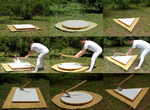
FORM to TIME
2019
FORM to TIME / TIME to FORM
M'MBUYO (PAST / CASSAVA / SQUARE) / TSOPANO (PRESENT / MAIZE / CIRCLE) / TSOGOLO (FUTURE / REFINED SUGAR / TRIANGLE).
If you always do what you did, you will always get what you got.
Green season (rain season) in Malawi is lean season, crops are growing, the food stocks (Maize) from last year finished or almost finished. This is circular / a circular rhetoric.
SEE PERFORMANCE VIDEO
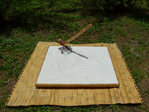
FORM to TIME MMBUYO
2019
FORM to TIME / TIME to FORM M'MBUYO (PAST / CASSAVA / SQUARE)
Square table top / inscripted khasu / square reed mat / 15kg Cassava pouder
The table tops on the reet mats is like past meeting present, as reet mats in Malawi are widespread used for story telling, transferring oral history, family gatherings, eating and sleeping I combine it with a table top which stands, in this case, for a western invention, but without the legs pretty useless.
Hammering the Khasu (hand plow) in the table top (see video) is as planting a knive in the table, challenging your opponent, maybe challenging him / her to change in the future, for the better.
Immediate popping up the question: who are you to tell the other what to do?!?
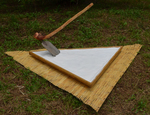
FORM to TIME / TSOGOLO
2019
FORM to TIME / TIME to FORM TSOGOLO / FUTURE
Triangle tabel top / inscripted Khasu / triangle reet mat / 7kg refined sugar

FORM to TIME / TSOPANO
2019
FORM to TIME / TIME to FORM
TSOPANO / PRESENT
Circle tabel top / inscripted Khasu / circle reed mat / 10kg maize flour

Sketch for Sydney NSW
2019..
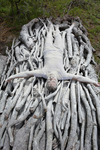
White Element 011
2019
White element 11 (19-26/ 3-2017) Subtitle: Several ways to deal with a "readymade".
Forrest reserve Lusaka, Zambia Mixed media: Performance, wood pile (dimensions: 486cm L x 258cm W x 104cm H), maize and cassava flour.

WHITE ELEMENT(12) / OUTSIDE
2019..

WHITE ELEMENT(12) / OUTSIDE
2019..

WHITE ELEMENT(12) / OUTSIDE
2019..

White Element(s) 12 / Inside
2019..

"Big 10" Chief Chair
2018
'The Big Ten' chief chair.
Unilever / Nestlé / Johnson&Johnson / Kraft-Heinz / Pepsico / General Mills / Mars / P&G / Kellogg's / Coca-Cola.
The big 10 food Multinationals.
Like the chief-chair is made specially for the chief, the 'big five' chair is purely made for tourists, this 'big ten' chief chair is specially designed and crated for another purpose, for an other kind of people or person.
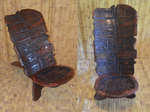
"Big 167" Chief Chair
2018
"Big 167" Chief chair.
On the chair backrest is a selection of 15 largest out of 167 international NGO's working in Malawi, as registered on 30-11-2016 on www.congoma.mw (Paid up members at 30-11-2016).
Congoma (Council for Non Governmental Organisations in Malawi) is the umbrella body where NGO's (international and national) have to pay membership after they officially have been registered in Malawi.
The seats bottom text states:
A selection of NGO's working in Malawi
There were 543 registered NGO's, from which 167 international,
in Malawi (Southern Africa) on 30-11-2016.
Mahogany wood turned into art, which maybe "feels better" than it would have been 'turned into 'tourist kitsch'. The same tree will be planted, for every 2 chief chairs (1 tree provides wood for 2 seats), as a sign of good will.
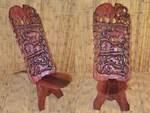
"Big 5" Chief Chair
2018
The "big five Chief-chair" seen at many "Africa tourist Art&Crafts markets", this one is in Lilongwe, Malawi. The artist bought it and brought it home to study it. In the near future it might / will become a part of an installation.
The Chief-chair is like a throne for the highest in hierarchy in the traditional village in Malawi (and Zambia) amongst other countries. Often they contain a male and female portrait, village scene, food and maybe a warrior. They differ per village to village.
The big five (Elephant / Rhino / Lion / Buffalow / Leopard) you see here is a theme that is specifically designed for the tourists and finally home they can be their own chief in their own thrown. Like the artist is sitting in it and is updating his website, but he aint a chief.

"Big 6" Chief Chair
2018
'The Big 6' chief chair.
Monsanto / DuPont / Syngenta / DOW / BAS-F / Bayer.
The big 6 chemical Multinationals selling seeds and controlling more and more of this market. The artist also put Seed-Co there which states "The African Seed Company" but already 30% of the shares are taken over by a French company Limagrain (logo put on the left there). Like Monstanto took over Dekalb and Cargill and DuPont Pioneer and Pannar and Syngenta took over Zambian company MRI seeds.
These large companies (most of them with only chemical history) are pushing out local knowledge and idea’s, using African (already cultivated there) seeds, (genetically) modify them and put copywrite (and restrictions) on them (without paying for the use of the old knowledge), make the seeds hybrid what also means you can not multiply them as a farmer and force small farmers to also use the companies knowledge, pesticides / herbicides and fertilizers.

"CHIEF CHAIR SHUFFLE"
2018
Here you see, far to the right, the specially ordered "Chief Church Chair", than the "Big 167 Chief Chair" (amount of international NGO’s in Malawi in 2016) and to the far left you see the 'Big Six Chief Chair', which talks about the 6 multinational seed companies (taking over more and more small businesses, claiming copywrites and put structures in order to control this market more and more) and in the middle left the 'Big Ten Chief Chair' (about the 10 food multinationals).
All 4 chairs are special ordered by the artist, in response to the chairs which are specially made for tourists, thinking they are buying something "originally African", which originally function as an attribute of power, as a tribal symbol and for a westerner a piece of ethnic art.
What is originally, or specific, African tradition culture, is shifting, raising the question: who do you allow having a sit on your chair and change your direction?

Forms and Context
2018Forms and Context to Nature
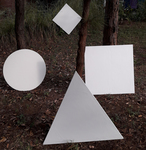
Forms to Nature
20184 basic white 3D forms placed in Nature, to show where these basic forms are coming from are where nature is build out from, if I listen, and hear and interpret freely, the words of Cezanne, the cubists and the minimalists. This is my free, visual translation.

Forms to Nature
20184 basic white 3D forms placed in Nature, to show where these basic forms are coming from are where nature is build out from, if I listen, and hear and interpret freely, the words of Cezanne, the cubists and the minimalists. This is my free, visual translation.

Ghost Trees
2018View from the Tarmac Art installation specially made for Tumaini Festival 2018 (2-3 november). 8 white bundels of white painted tree branches where standing as a memorial for the fallen trees by deforestation world wide, Malawi and Dzaleka. It is also a minimalistic site specific art installation. The branches will be donated to the people of Dzaleka.

Ghost Trees
2018Art installation specially made for Tumaini Festival 2018 (2-3 november). 8 white bundels of white painted tree branches where standing as a memorial for the fallen trees by deforestation world wide, Malawi and Dzaleka. It is also a minimalistic site specific art installation. The branches will be donated to the people of Dzaleka.

Ghost Trees
2018Art installation specially made for Tumaini Festival 2018 (2-3 november). 8 white bundels of white painted tree branches where standing as a memorial for the fallen trees by deforestation world wide, Malawi and Dzaleka. It is also a minimalistic site specific art installation. The branches will be donated to the people of Dzaleka.
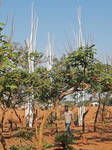
Ghost Trees
2018Art installation specially made for Tumaini Festival 2018. 8 white bundels of white painted tree branches where standing as a memorial for the fallen trees by deforestation world wide, Malawi and Dzaleka. It is also a minimalistic site specific art installation. The branches will be donated to the people of Dzaleka.

'Lowered Circle’
2018
'Lowered circle’
Cassava flour / red soil / wood glue / varnish spray paint on canvas
44,5cm x 75cm x 3cm
Color red soil is used here as ‘natural available fertile soil’ which is getting rare and disappearing because of monoculture agriculture. As a result of deforestation all the fertile soil that’s left is flushing into the rivers and into lake Malawi (raising the bottom of Lake Malawi and affecting fish population).
Color ‘white crème’ Cassava is in this series because it represents one of the "original" staple foods (besides sorghum, etc. ) in Malawi (and Zambia) before maize took over (as it took over diversity, the staple food market and “food” politics). Cassava represents tradition and maybe a look back to the older and maybe "better" days for some (farmers and poor people depending highly on this “easy accessible” staple food which better suited the local conditions and environment).

"New Forms" New Stories
2018
The reed mat, cultural very important for Zambia and Malawi, historical the place for oral history.
Triangle, square and circle are important in the art history, building blocks for minimalism and cubism and undeniable the most used mathematical symbol and as graphical icon.
Here they are combined. Iconic Cultural Historical Material in process lead to new stories.
These 3 special shapes where a special order to Julius and Watson (Lilongwe) and they asked the ladies in their village, who are holders of this craft, to create these 3 odd shaped mats for the sake of art.

Original Reed Mat
2018
Original Malawian Reed mat.
February 2018
Reed / henp-rope / twig-rope
242cm x 131cm.
Learned from Zambian contemporary artist David Daut Makala the reed mat plays and important role in the Zambian and Malawian culture. To sit on, eat from, to sleep on and to tell stories from as Zambia and Malawi history is in a large part oral, from mouth to mouth. It is an important individual and/or household possession.
Working with the khasu, maize, maisflour, table and chairs, it was only logical to find one, order one specially made for this purpose and buy one and ask around for personal meanings and/or stories.

Reet Mat Circle
2018
Reet Mat Circle
Reed / henp-rope / twig-rope
Diameter: 148cm to 147cm
February 2018.

Reet Mat Square
2018
Reed Mat Square
Reed / henp-rope / twig-rope
150cm x 150cm
Feruary 2018

Reet Mat Triangle
2018
Reet Mat Triangle
Reed / henp-rope / twig-rope
152cm high x 172cm base
February 2018

'Tilted Square’
2018
'Tilted Square’
Maize flour / Lake Malawi Beach Sand / wood glue / varnish spray paint on canvas
44,5cm x 75cm x 3cm
A reflection of the present and the future of Malawi. 'Tilted Square' is consisting of Lake Malawi "beach sand" (reflecting unfruitfulness) with the white square in maize flour (standing for making the soil unfertile). Of course I wish the opposite to happen.
Sand is in this series as it is the ultimate unfruitful soil for farming and from lake Malawi because this lake is the end station of a lot of fruitful soil flushing in the Lake because of deforestation. Causing the lake bottom to rise and killing a lot of fishes because of changes is water chemical concentrations.
Maize flour is in this series because it is a food / crop item causing (farming by humans is) deforestation.

TSOGOLO 02
2018..

TSOGOLO 02
2018..

TSOGOLO 02
2018..

WHITE ELEMENT 011
2018..
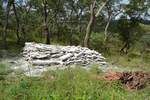
Baptizing
2017
Art project picture 05
After 'I' was being baptised on the pile of wood and walked of, I returned with more maize flour and cassava flour to baptizing the woodpile until it totally turned white, into a white element, my eleventh white element I created in my artist career.
Working with maize and cassava flour makes it even more site specific because these crops are the main reason of deforestation as agriculture land is all too often created by cutting down forests. But I also mean it here in an economic and political way. For example: Corn flour (white) in Zambia and Malawi are subject of political influence (price and distribution) and corruption (in Malawi there is a food shortage right now (rain season 2017) because the emergency stock (enough for 3 years) was sold before there was an emergency, to benefit a few). A more personal observation (but far more less worse that the first): in the village we stayed in Zanzibar we were drinking instant coffee while they grow coffee there but it was not for sale in the surrounding islands and villages because it is to expansive to them. Saying they are cheap labour, but not given what they harvest, because it is meant for export and others to make more profit. This effect is also seen a lot in the ‘cacao beans farming’.
As we all know the same food items are not equally distributed all over the world mainly because of a strange and complex combination of supply and demand, politics, international economy, local economy and/or due to high transport costs (especially when a country is land locked).
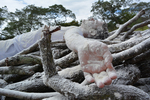
Being baptized 01
2017
Art project picture 03
After being one with the wood pile for a while I returned in white, lay down again in on other posture after I was being baptized with maize flour and cassava flour.
Deforestation is the main focus in this art project where I “investigated” tree ways to handle with this ready-made rectangular object. Looked at it from another angle we could say it is a symbolic and ritualistic way to “mourn” about the loss of these trees in a country (Zambia) where 90% of the people are believing in a self-proclaimed Cristian nation failing to protect the environment and its animal wildlife, especially when it is a borderline case. We could also questioned what is mourned here: that the trees are illegally demolished in particular or that the people are unable to be strict about the borders of a protected forest area. When you always give way on a borderline case in loss for nature, where will it end? Making a site specific artwork on this found object, or call it readymade art, was a bless to me, but will it be a bless to humankind remains the question.
Using Maize and Cassavas flour in this combination I hope will provoke the discussion (in Zambia and Malawi at least) what is cultural staple food/eating tradition or “forced on” tradition, or at least know what your history is and tell (remember) it correctly. If I do I do that myself is one my quest as well, but I try my best. There are traces found in the history of maize flour stating this food was even brought in to Africa through the slave traders, well, I only know of what I read that maize plants are cultivated in South-America before the maize plants (and maize flour) reached Africa.

Being baptized 02
2017
Art project picture 04
After being one with the wood pile for a while I returned in white, lay down again in on other posture after I was being baptized with maize flour and cassava flour.
Deforestation is the main focus in this art project where I “investigated” tree ways to handle with this ready-made rectangular object. Looked at it from another angle we could say it is a symbolic and ritualistic way to “mourn” about the loss of these trees in a country (Zambia) where 90% of the people are believing, in a self-proclaimed Cristian nation, failing to protect the environment and its animal wildlife, especially when it is a borderline case. We could also questioned what is mourned here: that the trees are illegally demolished in particular or that the people are unable to be strict about the borders of a protected forest area. When you always give way on a borderline case in loss for nature, where will it end? Making a site specific artwork on this found object, or call it readymade art, was a bless to me, but will it be a bless to humankind remains the question.
Using Maize and Cassavas flour in this combination I hope will provoke the discussion (in Zambia and Malawi at least) what is cultural staple food/eating tradition or “forced on” tradition, or at least know what your history is and tell (remember) it correctly. If I do I do that myself is one my quest as well, but I try my best. There are traces found in the history of maize flour stating this food was even brought in to Africa through the slave traders, well, I only know of what I read that maize plants are cultivated in South-America before the maize plants (and maize flour) reached Africa.

Being one
2017
Art project picture 02
After the wood pile was found in the forest, I decide how it felt to ly on the wood pile, beeing one with the pile of wood and the surrounding it was in.
3 ways of dealing with a readymade object, found in a forest showing human demolition of trees to make way for roads in an attempt to make a residential area in a protected forest area. In other words: showing the rapid growth of a city and bad “human city planning”, a protected forest area has to make way.
Deforestation is the main focus in this art project where I “investigated” three ways to handle with this ready-made rectangular object. Looked at it from another angle we could say it is a symbolic and ritualistic way to “mourn” about the loss of these trees in a country (Zambia) where 90% of the people are believing in a self-proclaimed Cristian nation failing to protect the environment and its animal wildlife, especially when it is a borderline case. We could also questioned what is mourned here: that the trees are illegally demolished in particular or that the people are unable to be strict about the borders of a protected forest area. For viewing the performance film, klick on this "picture and text" page and you will find the link to You Tube. If (by clicking) you came on that "enlarged picture page" please scroll down on this window to find the film.

"BLACK"
2017
"BLACK"
Malawian grounded coffee (no artificial colours) on canvas (wood glue and varnish spraypaint).
75cm x 44,5cm x 3cm
Together with WHITE, BROWN and PINK this will formed into an installation.
An artwork on surface colour, human inequality (rich/poor and against discrimination), poverty (for the enrichment of a few), combined with a protest to unnecessary un-equal food distribution around the world and the unhealthy manipulation with food.
Malawian Coffee is used as a product to 'paint' with as coffee is a "luxurious" product and a product that stands for unfair payments to (a lot of) coffee farmers for the enrichment for a few dealers and some multinationals.
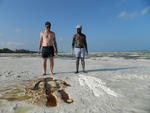
BROTHERS' PLAY. Coloring result.
2017
Video still 04:
Looking at the result, together.
“BROTHERS' PLAY” is a visual art performance done by two performers from two completely different continents meeting each other in visual art and beyond. The performance is mainly about humanity and its continuously inability to go beyond looking towards each other in a “black and white mind set”.
This performance was executed on Paje / Jambiani beach Zanzibar, melting pot of cultures, spices, food and believes in which the (Indian) Ocean plays a big role.
For viewing the performance film, klick on this "picture and text" page and you will find the link to You Tube.
If (by clicking) you came on that "enlarged picture page" please scroll down on this window to find the film.

BROTHERS' PLAY. Disappearance.
2017
Video still 08:
The sea gives, the sea takes.
Before the sea takes the installation away and wipes it out, the water comes up slowly and that is where an important and interesting process is going on which deals with mixing, stirring, dissolving, diluting and insolubility. Processes which are more interesting than “black and white” thinking. After that, the mixter is taken in to the sea together, where it will be positive food for thoughts.
For viewing the performance film, klick on this "picture and text" page and you will find the link to You Tube.
If (by clicking) you came on that "enlarged picture page" please scroll down on this window to find the film.

BROTHERS' PLAY. Food is politics and art.
2017
Video still 07:
The upcoming sea is crawling towards the short lived "art installation".
I’m not using food items easily (for an art work) in a country (and maybe the whole continent) where so many people are struggling for their daily energy (food) intake and many die not succeeding their goal. It is maybe more because of that why I turn food in to an art work as art materials. With using brown/black and white food items I also like to point towards the strange processes in making some food items look and smell different (more attractive, nicer smell, etc. (all to sell more). For example purification for making white items extra white (sugar, salt, rice, flour etc. not necessarily making it more healthy) and adding additives in a lot of food items not necessarily making them more healthy to eat, only longer lasting and tasting better and sometimes more addictive (sugar, fat, regulators, stabilizers, colours, flavours, preservatives, etc.).
For viewing the performance film, klick on this "picture and text" page and you will find the link to You Tube.
If (by clicking) you came on that "enlarged picture page" please scroll down on this window to find the film.

BROTHERS' PLAY. Food items used.
2017
Video still 05:
Body imprint with colouration of the opposite colour of skin made with food items.
Working with black/brown and white food items makes it even more site specific (locally purchased items), economic and political. For example: Corn flour (white) in Zambia and Malawi are subject of political influence (price and distribution) and corruption (in Malawi there was a food shortage in the 2015/2016 harvast year because the emergency sock (enough for 3 years) was sold to benefit a few). A more personal observation (but far more less worse that the first): in the village we stayed in Zanzibar we were drinking instant coffee while they grow coffee on the mainland of Tanzania, but it was not for sale on Zanzibar (for a reasonable price at least)!.
As we all know the same food items are not equally distributed all over the world mainly because of a strange and complex combination of supply and demand, politics, international economy, local economy and/or due to high transport costs (especially when land locked). With using food items I also like to point out the fact that basically a few big multinational consumer goods companies (KraftHeinz, Coca-Cola, General Mills, Kellogg’s, Mars, Unilever, Johnson & Johnson, P&G and Nestlé) “decide” what it cost (on their maximum profit), what we eat and where. They would probably call it a healthy response to “supply and demand”.
For viewing the performance film, klick on this "picture and text" page and you will find the link to You Tube.
If (by clicking) you came on that "enlarged picture page" please scroll down on this window to find the film.

BROTHERS' PLAY. Imprint.
2017
Video still 03:
Empty body imprints.
The body imprints on the beach are, in this context, also an “action of play” (referring to the artist his child memories, him playing as a child on the beach), which is giving an extra layer and / or insight of that person playing in/with his own body imprint. Besides that is “playing” is an opposite / contrasting action towards the hard working fisherman and seaweed farmers. This is reflecting (and should make us sensitive to the fact) the tourist destination which Zanzibar is, wilts their original inhabitants are too poor to travel (for fun, holiday, etc. but also many times to poor to travel to the nearest hospital!!) and have to work hard as fisherman or the woman who work in the harsh seaweed farming. It is this contrast and unfairness between "the west" and "Africa" which is not ok.
For viewing the performance film, klick on this "picture and text" page and you will find the link to You Tube.
If (by clicking) you came on that "enlarged picture page" please scroll down on this window to find the film.
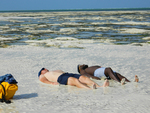
BROTHERS' PLAY. Imprinting.
2017
Video still 02:
Making body prints in the wet white sand seems to be an obvious statement to make while we are playing on the beach.
This performance and installation artwork is also a continent-, time- and site- specific installation executed on a quiet, white tropical beach on Zanzibar which last as long as the (sea) tide is not taking it away.
This performance was executed on Paje / Jambiani beach Zanzibar, melting pot of cultures, spices, food and believes in which the (Indian) Ocean plays a big role.
For viewing the performance film, klick on this "picture and text" page and you will find the link to You Tube.
If (by clicking) you came on that "enlarged picture page" please scroll down on this window to find the film.
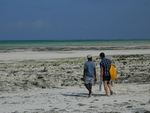
BROTHERS' PLAY. Meeting point.
2017
Video still 01:
Meeting on the beach and decide to go and "play on the beach" together in harmony and joy.
FILM: For viewing the performance documentation film, klick on the picture and you will find the link to You Tube. If you are on that "enlarged picture page" please scroll down on this window to find the film.
“BROTHERS' PLAY.” is a visual art performance done by two performers from two completely different continents meeting each other in visual art and beyond. This meeting was on Paje / Jambiani beach Zanzibar, melting pot of cultures, spices, food and believes in which the (Indian) Ocean plays a huge role. Sadly enough this island played also a huge role in slave trading which is a history fact that this artwork cannot do vanish or change in a positive sense, but it likes to present a (small) new positive gesture against these negative human actions (of the slave traders / buyers / users) and negative history for the once who were affected. This art work of course is a very small gesture, and in no relation to the huge impact of what happened to those who were effected.

BROTHERS' PLAY. Showing color.
2017
Video still 06:
Showing true color.
Filling the body imprints by the performers with the “two” contrasting food item colors is an "obvious reference" to their skin color, and in this situation the colors of the food items were not matching their skin color, but where intentionally swapped. Because, maybe, the “white” performer has a more “brown” mind-set than one could observe from just the outside, and the “black” person maybe has a more western mind-set that one can access externally, still we cannot wipe out there backgrounds and histories and that is way they are performing together and show this to you in a positive mindset and and wanting to move constructively forward together (as one). For viewing the performance film, klick on this "picture and text" page and you will find the link to You Tube.
If (by clicking) you came on that "enlarged picture page" please scroll down on this window to find the film.

"BROWN"
2017
'BROWN'
Charcoal (sustainable charcoal by Kawandama hills plantation) dust (no artificial colours) on canvas (wood glue and varnish spray-paint).
75cm x 44,5cm x 3cm
Together with BLACK, WHITE and PINK this will formed into an installation.
An artwork on surface colour combined with a protest to unnecessary un-equal food distribution around the world and the unhealthy manipulation with food.
Charcoal is in this 'series of work' because it is 'overused' in Malawi for cooking (probably as result of deep poverty) and leads to further deforestation (together with brick burning) as farming did the first large stretch of deforestation and still does.
Using charcoal dust as an art material is not necessary spoiling a heating resource, but transforming an important material into an artwork which meaning would not be there if another material would be used.

Centered Circle
2017
'Centered circle'
Nestle strawberry drink powder and Maize flour, wood glue and varnish spray-paint
44,5cm x 75cm x 3cm
Color pink is coming from Nestlé strawberry drink power and using a food item from Nestlé, I want to point out I'm interested in the taunting role of the 10 main food multinationals (Nestlé / Unilever / KraftHeinz (2015) / Coca-Cola / Pepsico / Kellogg's / Johnson&Johnson / P&G / Mars / General Mills (beware of the sudden changes of fusions in this world)(source: Huffingtonpost).
With taunting is meant: getting rich over the back of the poor (maybe a side affect, but it is a known side effect which could and should be prevented), the history of exploitation of poor people in poor countries (in Africa: Unilever) and their role in the inequality of food distribution over de world and the almost monopoly possession of resources (money and other sources). I’m not saying they all do this or they all do this in the same extent, but they are all multinationals, containing huge amount of power and money in a way which is repulsive.
Color ‘Natural white’ maize flour is used here as pointing out its present day’s main staple food source after it took over this staple food market, it minimalized diversity and it stands for its political use (it keeps the poor farmers poor) in Africa (Zambia and Malawi) as much it stands for more deforestation and a not so healthy main food source (white carbohydrates = sugar) under the less privileged.

Food Triptych
2017
Food triptych:
Triangle, square and circle in a new context together, as the food powders and charcoal add new layers.
This 3 panel work tells a more complex story than just triangle, square and circle.
Remember your first mathematic lessons where these forms popped up with all kind of different equations to be solved? Visiting Zambian and Malawian schools does realize that this is universal. Visiting many cultural places (amongst them Mua Mission Malawi and Wayiwayi Art Studio and Gallery in Livingstone, Zambia) several examples where found of the use of circle, triangle and square as general used symbols and in Africa this history goes way back in time and maybe even before they popped up in Europe.
These forms where, later in history, the main building blocks (though he spoke about sphere, cone, cube and cilinder) in the theoratical approach of Paul Cezanne (which finally led to cubism) and heavily used in the art movement minimalism and post-minimalism. In the art practise here is is also used on a regular bases as honour to minimalism and post-minimalism. In the African context here, it is more used as a start to explore the use of these forms / symbols in Zambia and Malawi and try to find historical evidence of their already long existence.

Lowered Square
2017
'Lowered square'
Maize and cassava flour, wood glue and varnish spray-paint.
44,5cm x 75cm x 3cm
Color ‘white crème’ Cassava is in this series because it represents one of the "original" staple foods (besides sorghum, ) in Malawi (and Zambia) before maize took over (as it took over diversity, the staple food market and “food” politics). Cassava represents tradition and maybe a look back to the older and maybe "better" days for some (farmers and poor people depending highly on this “easy accessible” staple food which better suited the local conditions and environment).
Color ‘Natural white’ maize flour is used here as pointing out its present day’s main staple food source after it took over this staple food market, it minimalized diversity (representing monoculture) and it stands for its political use (it keeps the poor farmers poor) in Africa (Zambia and Malawi) as much it stands for more deforestation and a not so healthy main food source (white carbohydrates = sugar) under the less privileged,

"PINK"
2017
"PINK"
Cassava powder wood glue paint on canvas (wood glue and varnish spraypaint).
75cm x 44,5cm x 3cm.
Together with BLACK, BROWN and WHITE this will formed into an installation.
An artwork on surface colour, human inequality (rich/poor and discrimination), poverty (for the enrichment of a few), combined with a protest to unnecessary un-equal food distribution around the world and the unhealthy manipulation (sugar, salt and grease) as addictive additives) with food.
Cassava is in this serie of 4 "paintings" because it, in contrast to 'WHITE', represents one of the "original" staple foods in Malawi (and Zambia) before maize took over (and diversity, the staple food market and politics). Cassava represents tradition and maybe a look back to the older and maybe "better" days for some (farmers and poor people depending highly on this cheap staple food).

"PINK"
2017
"WHITE"
Nestlé Strawberry flavoured strawberry drink powder (no "artificial" colours, as stated on the label) on canvas (wood glue and varnish spraypaint),
75cm x 44,5cm x 3cm (the size which fit a 25kg Zambian / Malawian maizeflour bag).
Together with 3 other works: BLACK, BROWN and PINK this will be formed into an installation.
An artwork on surface colour, human inequality (rich/poor and against discrimination), poverty (for the enrichment of a few), combined with a protest to unnecessary un-equal food distribution around the world and the unhealthy manipulation (sugar, salt and grease) as addictive additives) with food.
Using almost 1kg of this Nestlé powder as an art material is not necesary spoiling food, but transforming an important material into an artwork which meaning would not be there if an other material would be used. Though using food items in one of the poorest countries of the world feels ambiguous, but the feeling I have to do this and that it is rightful (and in a respectful manner) to do so is stronger.
Using a food item from Nestle, the role of the 10 main food multinationals (Nestlé / Unilever / Kraft-Heinz / Coca-Cola / Pepsico / Kellogg's / Johnson&Johnson / P&G / Mars / General Mills) in this inequality, is Incorporated.

Readymade, captured
2017
Art project picture 01
The wood pile found on a walk in the forest, as it was, "just a wood pile".
dimensions: 486cm L x 258cm W x 104cm H
White element 011
Subtitle: Several ways to deal with a "readymade".
Forrest reserve Lusaka, Zambia
Mixed media: performance, wood pile (dimensions: 486cm L x 258cm W x 104cm H) with maize and cassava flour.
19-26 March 2017
For viewing the performance film, klick on this "picture and text" page and you will find the link to You Tube. If (by clicking) you came on that "enlarged picture page" please scroll down on this window to find the film.

Tilted Triangle
2017
'Tilted Triangel'
Grounded Malawian coffee, Charcoal dust, wood glue and varnish spray-paint on canvas
44,5cm x 75cm x 3cm
Color black charcoal is used here because it is “overused” in Malawi for cooking (probably as result of deep poverty and the lack of payable alternatives) and leads to further deforestation. Farming did the first large stretch of deforestation and still does.
color brown Malawian grounded Coffee is used here as a product to 'paint' with as coffee is a "luxurious" product and a product that stands for unfair payments to (a lot of) coffee farmers (who hardly can afford coffee themselves) for the enrichment for a few dealers and some multinationals.
Using food powder as colors is ethically not so easy. Using 1kg of this Nestlé powder, 1kg of maize flour, 500 grams of coffee and 500 grams of cassava flour as an art material is not spoiling food, but transforming a food item into important necessary art-material into an artwork which meaning would not be there if another, normal art material (paint) would be used. In the context of Malawi, one of the poorest countries in the world, this is not so easy, but important to state.

TSOGOLO / 1 out of 13
2017
TSOGOLO (meaning ‘future’ in Chichewa) is a site-specific art installation where 13 cutdown trees are "expressing their surrender" with "waving the white flag". The word TSOGOLO is stated on these flags and the letters are crumbling off, fading away, expressing a fading future.
This installation art project is situated on the border of old farm land which is turned into a park / large garden around the luxury lodge called Kumbali. One of the borders is formed by the park of State House (residency of the Malawian president) and the Lilongwe river is the other border. The site of the art work is situated at a corner of the park, next to the river and is very visible from the other side of the river. It is situated close to where people from the village on the other site cross the river, entering the park and in some case illegally collect wood. Picking wood sticks fallen from the trees is one thing, but cutting them down in large numbers is another thing, especially if that is done to commercially produce charcoal.

TSOGOLO / fading future
2017TSOGOLO means future. This word is spray-painted on the flag (wheat flour bag, cut in half) and then painted over with charcoal powder and wood glue which under the influence of the wind will erode off of the bag, the word fading in time.

TSOGOLO / other side
2017View from the other side of the river looking towards Kumbali, showing the 13 flags and white poles (1 of them is behind a tree and not seen on this photo) and this is the villagers’ view of the installation. 13 flags showing the word TSOGOLO on white flags on white poles, as it is saying: this is the future you / we are asking for.

TSOGOLO / white flag
2017
White flags are used in war situations to surrender, here they are used in a different way, saying that if “trees would surrender” “nature would surrender”. Us humans should however be the ones to surrender, because soon we will extinct if we don’t take care of the nature and environment in the world. This is a message to all, not specifically only the ones that cut down the trees. That would be very naïve. Deforestation is a worldwide problem and one of the many examples how destructive you and I are.
This artwork will stay on site for a while and show itself to the people who enjoy nature but it is also made for the villagers on the other side of the river, maybe wondering what the flagpoles and flags are doing there. It would be great if the art work would create a new dialogue between all players in this situation.

WHITE ELEMENT 11
2017.

Black and White
2016Untoutched surfaces, no content to tell yet. Black and White next to each other in all their contrast.

Circle. Raking a large rectangular to a human size circle
2016
Raking a large rectangular (30 meter x 20 meter) to a human sized circle (diameter of 1 meter) and removing all that doesn’t belong (plastic, glass, poop, cigarettes, tins, bags). Spending 2 hours and 7 minutes on cleaning the beach in front of the rented holiday house at Lake Malawi.
For viewing the performance documentation film, klick on this "picture and text" page and you will find the link to You Tube.
If (by clicking) you came on that "enlarged picture page" please scroll down on this window to find the film.
When: Tuesday 18-10-2016
Time: 10.35 am to 12.42 pm
Where: Cape Maclear beach Malawi (Lake Malawi).

Dirt removing after raking.
2016
Raking a large rectangular (30 meter x 20 meter) to a human sized circle (diameter of 1 meter) and removing all that doesn’t belong (plastic, glass, poop, cigarettes, tins, bags). Spending 2 hours and 7 minutes on cleaning the beach in front of the rented holiday house at Lake Malawi.
For viewing the performance documentation film, klick on this "picture and text" page and you will find the link to You Tube.
If (by clicking) you came on that "enlarged picture page" please scroll down on this window to find the film.
When: Tuesday 18-10-2016
Time: 10.35 am to 12.42 pm
Where: Cape Maclear beach Malawi (Lake Malawi).

Not a grey result.
2016The story that lead to this result is the film to be wachted.

Performance outcome
2016
In this picture you see the "outcome of the performance" which is a triptych with the title: Who is affraid of Red, Yellow, Blue and the smell it creates?
FILM: For viewing the performance film, klick on the picture and you will find the link to You Tube.
If you are on that "enlarged picture page" please scroll down on this window to find the film.
Performance piece “Who’s afraid of Red, Yellow, Blue and the smell it creates” performed at the opening night (17-6-2016) of ENHLA KOMQONQO, The Unconscious Mind, Solo Exhibition by Vincentio Phiri.
Vincentio Phiri is an Abstract Expressionistic Zambian painter. For this exhibition we divided the exhibition space in 4 spaces and selected 4 artworks per space which are connected together to an emotion and a smell to the 4 selected works. also the touch sense is involved because the floors where covered with the material that smelled. Visitors has to walk on the substance to view the paintings. The 4 smells where: grounded coffee, sawdust and chips, ashes and African wet soil.
As the exhibition concept and designer I created an opening performance to “proper introduce by experience” Abstract Expressionism with a performance which deals with emotions, smells, senses and the “art creation process” in the Zambian Contemporary Art Context.

Realisation
2016
End result of performance when the work was just done.
All this time there was silence, the performers had no contact. This changed when the white canvas was turned black/brown and the black canvas was almost transformed into white. At that moment, the performers started to look at each other’s creations and to each other’s odd appearances. It didn’t stop there, as they then started to try out what happens if white materials where applied on 'black and brown' and the other way around. Mixing up the colors. This mixing continued until the performers where satisfied with the results and with each other. They then hugged, happy with the shared experience, bowed to the camera and walked out of the scene together as brothers in arms, gladly and happy as they were that mixing of colours doesn’t end up in greyness.

Reconciliation
2016
Performance in the end fase, where both performers hugged and "bow to the public that it is done and over".
All this time there was silence, the performers had no contact. This changed when the white canvas was turned black/brown and the black canvas was almost transformed into white. At that moment, the performers started to look at each other’s creations and to each other’s odd appearances. It didn’t stop there, as they then started to try out what happens if white materials where applied on 'black and brown' and the other way around. Mixing up the colors. This mixing continued until the performers where satisfied with the results and with each other. They then hugged, happy with the shared experience, bowed to the camera and walked out of the scene together as brothers in arms, gladly and happy as they were that mixing of colours doesn’t end up in greyness.
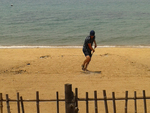
Rectangular. Raking a large rectangular to a human size circle.
2016
Sweep clean your “own” beach first.
Raking a large rectangular (30 meter x 20 meter) to a human sized circle (diameter of 1 meter) and removing all that doesn’t belong (plastic, glass, poop, cigarettes, tins, bags). Spending 2 hours and 7 minutes on cleaning the beach in front of the rented holiday house at Lake Malawi.
For viewing the performance documentation film, klick on this "picture and text" page and you will find the link to You Tube.
If (by clicking) you came on that "enlarged picture page" please scroll down on this window to find the film.
When: Tuesday 18-10-2016
Time: 10.35 am to 12.42 pm
Where: Cape Maclear beach Malawi (Lake Malawi).
Human interactions: 3 groups of tourist walked by and didn’t say anything but just gazed, a kid wanted to help but didn't come back with his own rake and a villager was admiring my strength and wanted to sell a bonfire with music, starting 08.30pm that evening.

Scematic view Art Action
2016
Schematic representation on what “happened visually” in Art Action (part I) seen from a birds perspective (in absence of a drone).
This digital drawing shows in which forms I raked and cleaned the beach.
It is from a rectangular shape to a small circle shape in which I was trapped (so to speak) on the end.
These forms are important because they are representatives of forms used a lot (mainly?) in the Minimalistic art theory I endorse.

Transformation identity
2016
The performance started with the performers washing themselves with clear water. Next, they attempted to turn themselves into “the other” color, finding out that this is quite hard. After trials and errors, the performers turned to canvases that hung on the walls. One black canvas and one white canvas. The black canvas was "attacked" with white materials and the white canvas with black and brown materials.

Transforming surface 01
2016
The Performance has started, the performers putted on "the other color" and now are "attacking" the other color presented on the wall.
The performance started with the performers washing themselves with clear water. Next, they attempted to turn themselves into “the other” color, finding out that this is quite hard. After trials and errors, the performers turned to canvases that hung on the walls. One black canvas and one white canvas. The black canvas was "attacked" with white materials and the white canvas with black and brown materials.

Transforming surface 02
2016
Performers are still working on the presented colors and turn them in "the other" color.
The performance started with the performers washing themselves with clear water. Next, they attempted to turn themselves into “the other” color, finding out that this is quite hard. After trials and errors, the performers turned to canvases that hung on the walls. One black canvas and one white canvas. The black canvas was "attacked" with white materials and the white canvas with black and brown materials.

Transforming 'the other' 01
2016
Picture when you see the performers start to react on eacht other "colored" surface.
All this time there was silence, the performers had no contact. This changed when the white canvas was turned black/brown and the black canvas was almost transformed into white. At that moment, the performers started to look at each other’s creations and to each other’s odd appearances. It didn’t stop there, as they then started to try out what happens if white materials where applied on 'black and brown' and the other way around. Mixing up the colors. This mixing continued until the performers where satisfied with the results and with each other. They then hugged, happy with the shared experience, bowed to the camera and walked out of the scene together as brothers in arms, gladly and happy as they were that mixing of colours doesn’t end up in greyness.

Transforming 'the other' 02
2016
Picture when you see the performers start to react on eacht other "colored" surface.
All this time there was silence, the performers had no contact. This changed when the white canvas was turned black/brown and the black canvas was almost transformed into white. At that moment, the performers started to look at each other’s creations and to each other’s odd appearances. It didn’t stop there, as they then started to try out what happens if white materials where applied on 'black and brown' and the other way around. Mixing up the colors. This mixing continued until the performers where satisfied with the results and with each other. They then hugged, happy with the shared experience, bowed to the camera and walked out of the scene together as brothers in arms, gladly and happy as they were that mixing of colours doesn’t end up in greyness.

Transforming 'the other' 03
2016
In this performance picture you see the performance working on "the other side".
All this time there was silence, the performers had no contact. This changed when the white canvas was turned black/brown and the black canvas was almost transformed into white. At that moment, the performers started to look at each other’s creations and to each other’s odd appearances. It didn’t stop there, as they then started to try out what happens if white materials where applied on 'black and brown' and the other way around. Mixing up the colors. This mixing continued until the performers where satisfied with the results and with each other. They then hugged, happy with the shared experience, bowed to the camera and walked out of the scene together as brothers in arms, gladly and happy as they were that mixing of colours doesn’t end up in greyness.

Cairn Inside / Outside (INSIDE)
2015"Cairn Inside / Outside" Cairn Inside / Outside was part of an exhibition I curated, the 7th International Insaka Artist Workshop (Lusaka - Livingstone Zambia). The cairn was specially build at my request and executed by Norma D Hunter because she was (one of the artists (workshop participants) the intellectual mother of the "cairns and circles" inspirations at this workshop.

Kabwata Flats National Zambian colors Before / After
2015
In a nation where 'proudly Zambian' means just beeing proud of your country (and not called a natioanlist as in my home country) the colours of the national flag are nicely added to these flats in Lusaka, Zambia.
It is my preferenced transformation of a sad looking site in to a colourfull happy site, which is more a reflection of the Zambian people.

Kabwata Flats Pink Splashes (after Pop Art) Before / After
2015xx

Wall sculpture VAC Building Lusaka Outside found objects (paint tin cans)
2015In 2015 there was an 'Artist Call' for proposal how to "lift up" the outside walls of the "Visual Art Council" building. I thought it would be very much appropriate to use "used paint cans" and stick them in a nice pattern to the wall. In this case you get the creative meaning of this work, it is an outside site-specific installation reflecting to what is happening inside this creative building and I hope a lot of beautiful Zambian bird are going to nest in these empty cans. What a wonderful and happy site would that give in the future.

Water Tower Woodlands Lusaka
2015
In a nation where 'proudly Zambian' means just beeing proud of your country (and not called a natioanlist as in my home country) the colors of the national flag are nicely added to these flats in Lusaka, Zambia.
It is my preferenced transformation of a sad looking site in to a colourfull happy site, which is more a reflection of the Zambian people.

Zesco Tower Lusaka Before / After
2015
In a nation where 'proudly Zambian' means just beeing proud of your country (and not called a natioanlist as in my home country) the colours of the national flag are nicely added to these flats in Lusaka, Zambia.
It is my preferenced transformation of a sad looking site in to a colourfull happy site, which is more a reflection of the Zambian people.

White Element 006 / Rotterdam
2007
Rotterdam / Inside / Outside / White Element Aanschouw / After
Aanschouw White Element Rotterdam

De Aanschouw Preview Sketch
2004This is 'Cafe De Schouw' with (look at de small showcase at the wall right) also what is called the smallest gallery of 'Wittedewitstraat', a very well known gallery museum street in Rotterdam, Holland. The spaces is small, but we asked our selfs, can we open up this show case gallery to real public and make it a public space.

Montauk II / De Aanschouw 2004
2004
Het Willem de Kooning jaar is officieel geopend. Ties Ten Bosch, Wink Witholt en Camilio van Lenteren waren die gasten uit Noord voor: zij hieven vrijdag om 0.00 uur het 'Lang zal hij leven' aan en trakteerden op taartjes, slingers en champagne! Montauk ll, het schilderij dat als thema is gekozen voor deze reeks exposities, heeft te grote afmetingen om in De Aanschouw te plaatsen. Hierom kozen zij er voor om slechts de begeleiding van het schilderij te plaatsen: Montauk II Willem de Kooning (1904 - 1997) 1969 - oil on canvas 72,5 x 70.25" Dat zijn inches, welteverstaan. Voor het eerst worden bezoekers in de gelegenheid gesteld om daadwerkelijk de galerie te betreden om naar het werk te kijken. De toegang wordt vergemakkelijkt door de toevoeging van 'De Aantree' aan De Aanschouw. En de treden van de Aantree zijn op de openingsavond zelf al aardig gesleten. Lachen met die gasten van de Willem de Kooning.
Zie ook: http://www.aanschouw.nl/index.php?pageID=3&itemID=154
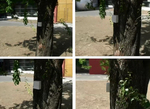
White Element 003 / Berlin
2004
White Element 003 / Berlin Tree 03
In this work I I just made a small gesture as I played with the 3rd tree on in the samen grasfield and to connect it with the 2 other trees I gave it a electrical socked size box / cube on its stam. just to mark it. It also is showing that this tree didn't inspire me to another form.

Performance Berlin Tree 01
2003
Performance Berlin Tree 01
Tree / artist / 2 white blocks
30cm x 60cm x 150cm (tree) / 15cm x 60cm x 60cm (on performer)
The tree and me in the same context, position and situation. More important, my reproductionssystem is blocked.
FILM: For viewing the performance film, klick on the picture and you will find the link to You Tube.
If you are on that "enlarged picture page" please scroll down on this window to find the film.
Berlin Tree 01 is a result of conceptualizing how humans "like" to capture nature. Like pigeon holders "ring" "their" animals, so I "ringed" a tree (to make it mine?). There is much more conceptual and minimalistic about this work, but this is enough writing for now.
Think about it: why capture, restrain and controle nature if we can not controle our own human explosive growth and all the environmental and ecological catastrophes as result of this overpopulation. Maybe we should restrain our self's and our offspring.
That way of thinking let me to make this performance.
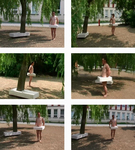
Performance stills
2003
Performance Berlin Tree 01
The tree and me in the same context, position and situation. More important, my reprodcutions system is blocked.
FILM: For viewing the performance film, klick on the picture and you will find the link to You Tube.
If you are on that "enlarged picture page" please scroll down on this window to find the film.
Berlin Tree 01 is a result of conceptualizing how humans "like" to capture nature. Like pigeon holders "ring" "their" animals, so I "ringed" a tree (to make it mine?). There is much more conceptual and minimalistic about this work, but this is enough writing for now.
Think about it: why capture, restrain and controle nature if we can not controle our own human explosive growth and al the environmental and ecological catastrophes as result of this overpopulation. Maybe we should restrain our self's and our offspring.
That way of thinking let me to make this performance.
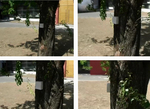
White Element 003 / Berlin Tree 03
2003
White Element Berlin Tree 03
Tree / plaster of Paris
5cm x 10cm x 10cm
White Element Berlin Tree 03 is my third work in this serie. The name is an "easy" derivation of place, time and what you see (a tree with a white element). Element is a name which could be used in the (post) minimalistic art movement, which I hugely appreciate. I concider the tree and the white element as 1 work of art. The size is the totally different than element 01 and 02, it is the size of a electrical socket (used in the Berlin academia).
In this installation time is playing an important role. The image is static, but the tree is not. It will move in the wind, it grows in diametre and the weather (natural elements) like rain, sun, wind are a life source to the tree but a danger to art.
Unnatural is one of the main issue’s here. Natural / Unnatural / Artificial / Art?
The choice for plaster was a deliberate one. Plaster is unnaturally white and both weak and strong. Nature is stronger and will overcome the artificial.
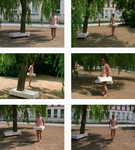
White Element on ME / Berlin
2003Performance to White Element 001 / Berlin.